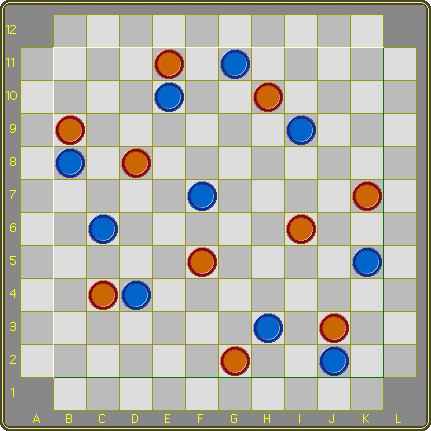Page 11 of 47
Pylyx |
On August 20, 2011 Luis Bolaños Mures alerted me on a contest called 'The Thousand Year Game Design Challenge', organized by Daniel Solis.
I thought I had a good entry in Sygo, Nick Bentley joined with Catchup, Luis himself entered his intruiging connection game Yodd and Mark Steere entered his Dots & Boxes simplification Flume. I also invited Corey Clark to join with Slither, but he didn't react.
Still it was his game that got me thinking about simple placement & movement combinations such as for instance employed in Slither. It lead to a chain of associative ideas that solidified in Pylyx on August the 31st.
I decided on a placement stage wherein players alternately place a man on a square satisfiying the 'free row & column' condition, despite the fact that there's a turn order advantage to consider. The alternative would have been the 'Marquisian Method' that I previously had employed in the twin games Swish & Squeeze. But I felt that player interaction in the placement phase would be preferable. Immediately after its publication Phil Carmody replied to the effect that he saw stalemate as a potential problem. I agreed and as yet gave columns the previously considered option to split, moving only the top part according to its height. It means that an immobile column will always have mobile top parts.
After a week I decided to add the four 10x1 sidebars to the board, excluding them from the initial set-up, but including them in the playing area. It puts an end to attempts to immediately wall in a single on the edge completely.
And then I decided, as far as inventing games goes, to call it a day. I did that before and of course you can never know, but I feel drained of ambition. It's hard to beat Symple and Sygo, and Pylyx didn't seem to bad a game to finish with. It wasn't to be though. It's in the blood and I was to go on till 2018.
enschede, december 1th, 2011
christian freeling
